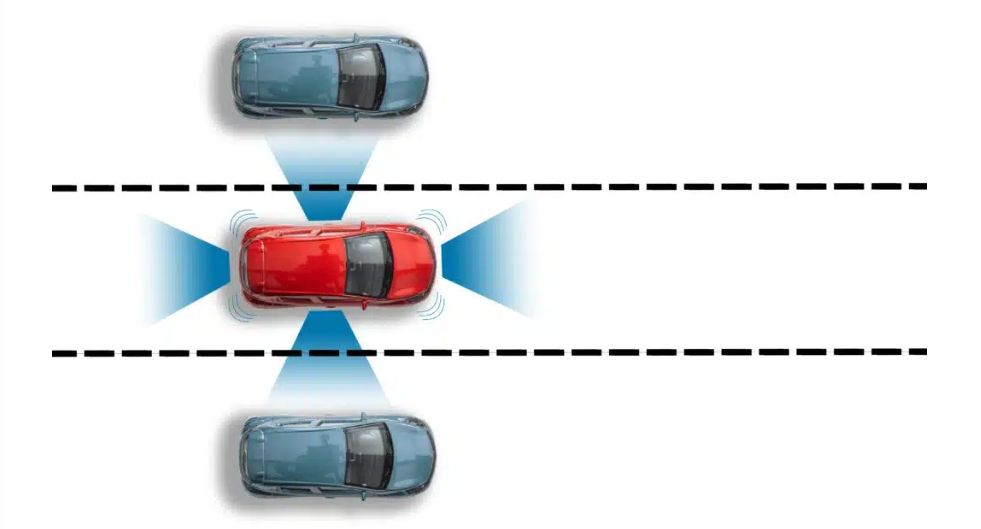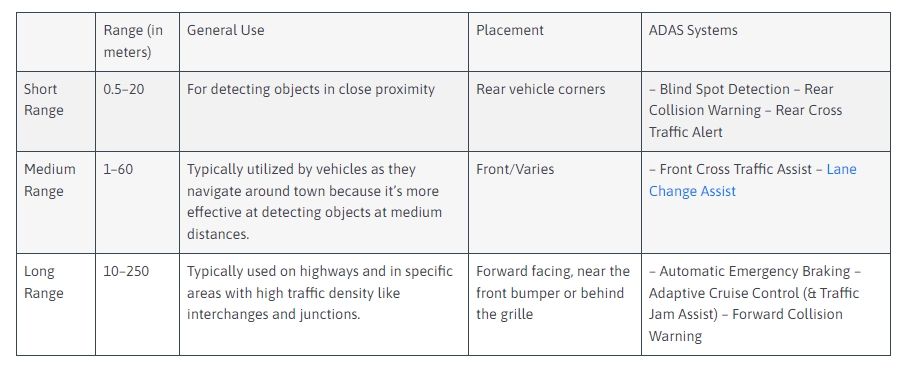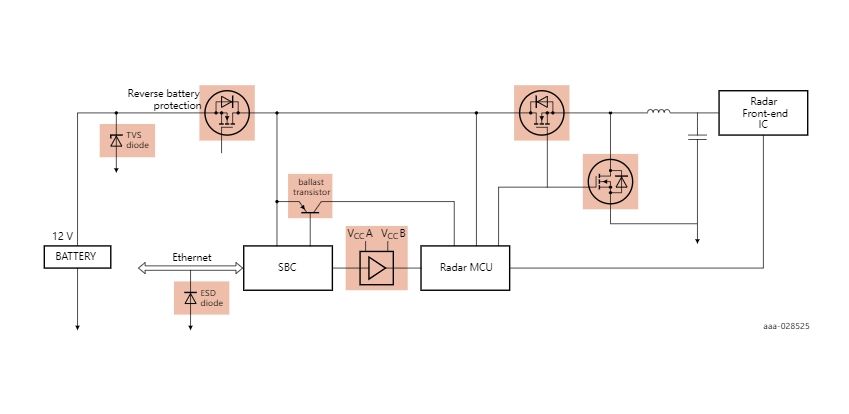Automotive radar sensors are often a vital component of Advanced Driver Assistance Systems (ADAS). Radar sensors require recalibration after certain events to ensure optimal performance. In this article, we will explain what ADAS radar is, how it works, and why it’s vital to calibrate.
What is an ADAS radar sensor?
ADAS radars are automotive radar sensors mounted to vehicles to ultimately provide drivers with safety alerts and enable safety maneuvers like Automatic Emergency Braking, Adaptive Cruise Control, Cross-Traffic Alert, and Blind Spot Monitoring. 
Vehicles can have forward and rear mounted ADAS radar sensors, to inform different safety systems. Forward-facing radars are typically mounted in the vehicles front bumper or grille. They help monitor forward distance to other vehicles and obstructions. In vehicles equipped with adaptive cruise control, they also help control the following distance to forward vehicles. Additionally, the radar sensor in car bumpers are mounted in a vehicle’s rear corners help to detect closer-range objects that are approaching from the rear.
How do automotive ADAS radar sensors work?
An ADAS radar sensor uses radio waves to detect vehicles and other obstructions in the environment. The time it takes for the pulse to return allows the computer (ECU) to calculate the other vehicle’s speed and direction.
Once determined, a vehicle’s ADAS systems use that sensor information to provide you with visual, haptic or audible safety alerts. In addition, depending on the specific ADAS system technology, radar sensor data can also be of use to take temporary control of driving functions such as braking, accelerating, steering, and so on.
There are three different automotive radar ranges used: 
How does radar compare to other ADAS technologies?
By definition, advanced driver assistance systems (ADAS) use sensors including cameras, lasers, and radar, to collect advanced information about the environment surrounding the vehicle. Data collected by ADAS radar sensors works in tandem with data from other ADAS sensors to provide a more complete picture of a vehicle’s surroundings.
Radar is often compared to other ADAS technologies, such as cameras and lidar. Cameras are the most common type of sensor in ADAS and they work well for detecting objects that are stationary or slowly moving. They’re not particularly good at detecting fast-moving objects because the time it takes for a camera to snap a picture is long in comparison to how quickly objects move. Lidars are like cameras, but they use light instead of radio waves. They’re also good at detecting objects in relatively close range (less than about 300 feet), but not for fast-moving or far away objects.
Radar sensors are much better at detecting moving vehicles, pedestrians, and other objects than cameras or lidars. They can see objects that are far away and moving quickly, which is why they’re of great use in many ADAS. Radar sensors also work well in all weather conditions, including rain, snow, and fog. Cameras and lidars can’t see through most types of harsh weather.
Each sensor type has pros and cons. That’s why it’s common for automakers to include multiple types of sensors that complement each other.
ADAS radar sensor module Design considerations
●With various radar options and multiple sensors needed for full 360 degree sensing space is extremely limited
●Move to ‘postage stamp’ radar sensor modules to save overall system space
●Move to CFP and LFPAK packages for space saving, thermal efficiency and system robustness
Automotive MOSFETs
The world's largest portfolio of AEC-Q101 qualified power MOSFETs
An in-depth understanding of automotive system requirements and focused technical capability enables Nexperia to provide power semiconductor solutions across a wide spectrum of applications. From driving a simple lamp to the sophisticated needs of power control in engine, body or chassis applications, Nexperia power semiconductors can provide the answer to many automotive system power problems.
Single bipolar transistors ≤ 100 V
A great choice of devices, and packages down to ultra-small sizes
Part of our extensive small-signal bipolar device portfolio, our single bipolar transistors are perfect for your switching and amplification applications. We also offer a variety of SMD packages including our ultra small leadless housing SOT883 for space-saving designs.
Product:
PNP low VCEsat Breakthrough In Small Signal (BISS) transistor in a medium power SOT89 (SC-62/TO-243) flat lead Surface-Mounted Device (SMD) plastic package.
NPN low VCEsat Breakthrough In Small Signal (BISS) transistor in a medium power SOT89 (SC-62/TO-243) flat lead Surface-Mounted Device (SMD) plastic package.
Automotive ESD Ethernet
ESD protection for automotive Ethernet applications
Ethernet is seen as an universal and flexible alternative to CAN or FlexRay networks. It is used for modules that need to process more data and need higher data rates such as driver assistance or back-bone networks. The standard BroadR-Reach has been defined by Broadcom and has been transferred into the OPEN Alliance Special Interest Group. In line with our ambitious quality philosophy, Nexperia offers tailored ESD protection concepts to secure Ethernet applications.
Product:
Fully OPEN Alliance IEEE 100BASE-T1 and 1000BASE-T1 compliant ElectroStatic Discharge (ESD) protection device in a small DFN1006BD-2 (SOD882BD) surface-mounted plastic package, designed to protect one automotive in-vehicle network bus line from the damage caused by ESD and other transients.
PESD2ETH1G-T
Fully OPEN Alliance 100BASE-T1 and 1000BASE-T1 compliant Electrostatic discharge (ESD) protection device in a small SOT23 surface-mounted plastic package designed to protect two automotive in-vehicle network bus lines from the damage caused by ESD and other transients.
Automotive Transient Voltage Suppressors (TVS)
For outstanding protection against transient over-voltage
Housed in very flat SOD128 or SOD123W packages, these TVS diodes save board space while guaranteeing industry-leading surge protection up to 600 W.
Product:
Unidirectional double ElectroStatic Discharge (ESD) protection diode in a common anode configuration, encapsulated in a SOT23 (TO-236AB) small Surface-Mounted Device (SMD) plastic package. The device is designed for ESD and transient overvoltage protection of up to two signal lines.
Unidirectional double ElectroStatic Discharge (ESD) protection diode in a common anode configuration, encapsulated in a SOT23 (TO-236AB) small Surface-Mounted Device (SMD) plastic package. The device is designed for ESD and transient overvoltage protection of up to two signal lines.
Logic voltage translators
An efficient solution for voltage matching
Bi-directional level shifter and translator circuits act as an interface between applications with different supply voltage and input-output voltage levels.
Our wide range of non-inverting level shifters and translators can help you find the exact solution you need.
ADAS Radar Calibration: Why it’s vital.
A car radar sensor can become misaligned due to fender benders, alignment changes, and adjacent repair work. This can cause them to give inaccurate readings. Some radar sensors are self-calibrating, but most are not…yet. Automotive radar calibration ensures that the sensor properly aligns and provides accurate information to your vehicle’s ADAS.
It is important to calibrate your automotive radar sensor after structural repairs, sensor removal or replacement, and removal of the front bumper or grille, to ensure that your car’s ADAS systems are operating as intended. If the radar is not calibrated correctly, it can provide warnings, steering, and braking interventions either too early or too late.
Calibration of automotive radar sensors is a complex process requiring a controlled environment, specialized equipment, precise measurements, and in-depth training. It’s not something you can do at home. Most auto shops don’t have the equipment necessary to handle ADAS calibrations. Due to several ADAS implementation problems, standalone calibration centers are fast becoming the solution when it comes to providing efficient, effective, and reliable calibration of ADAS sensors.
Previous: Electric power steering (EPS)